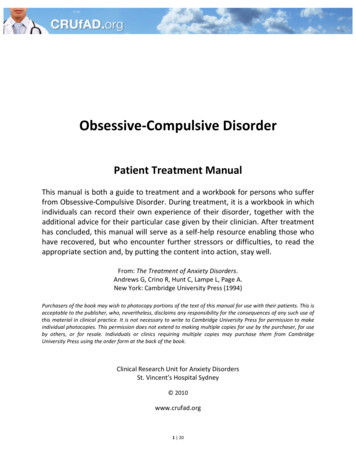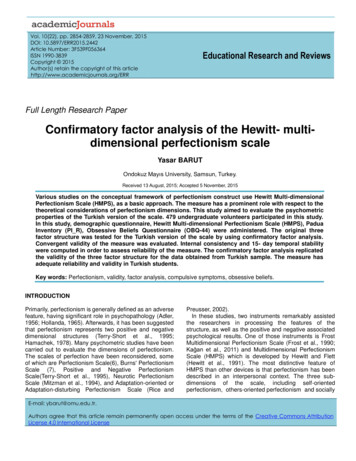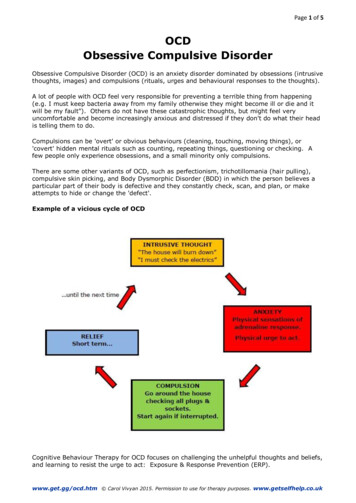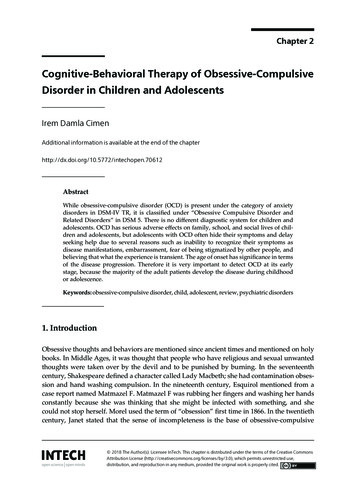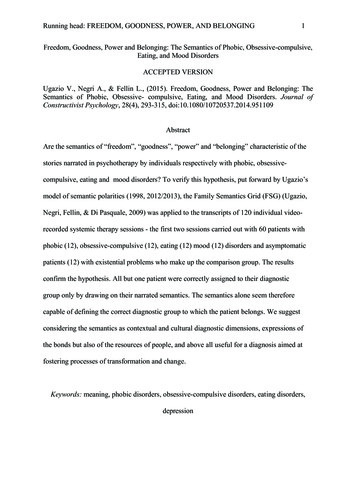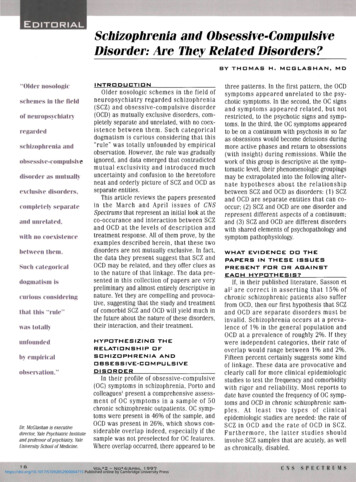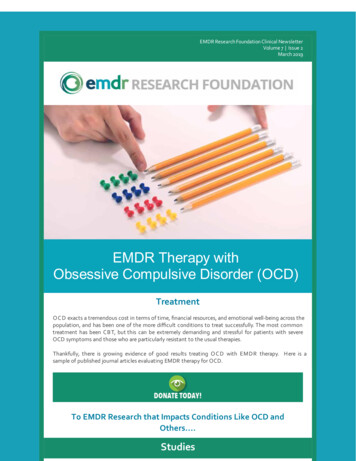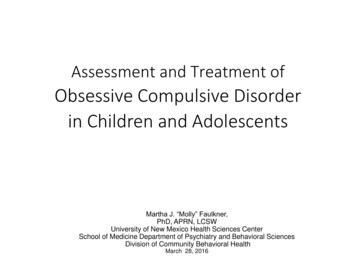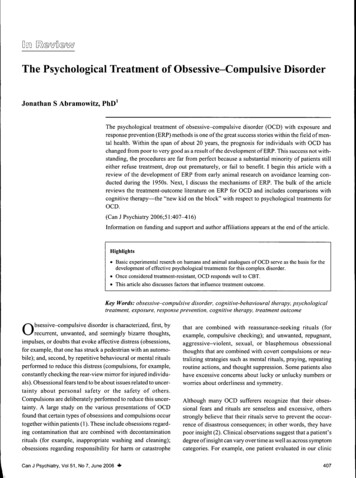
Transcription
The Psychological Treatment of Obsessive-Compulsive DisorderJonathan S Abramowitz, PhD'The psychological treatment of obsessive-compulsive disorder (OCD) with exposure andresponse prevention (ERP) methods is one ofthe great success stories within the field of mental health. Within the span of about 20 years, the prognosis for individuals with OCD haschanged from poor to very good as a result ofthe development of ERP, This success not withstanding, the procedures are far from perfect because a substantial minority of patients stilleither refiise treatment, drop out prematurely, or fail to benefit, I begin this article with areview of the development of ERP from early animal research on avoidance learning conducted during the 1950s, Next, I discuss the mechanisms of ERP, The bulk ofthe articlereviews the treatment-outcome literature on ERP for OCD and includes comparisons withcognitive therapy—the "new kid on the block" with respect to psychological treatments forOCD,(Can J Psychiatry 2006;51:407-416)Information on fiinding and support and author affiliations appears at the end ofthe article.Highlights Basic experimental reserch on humans and animal analogues of OCD serve as the basis for thedevelopment of effective psychological treatments for this complex disorder, Once considered treatment-resistant, OCD responds well to CBT, This article also discusses factors that influence treatment outcome.Key Words: ohsessive-compulsive disorder, cognitive-behavioural therapy, psychologicaltreatment, exposure, response prevention, cognitive therapy, treatment outcomebsessive-compulsive disorder is characterized, first, byrecurrent, unwanted, and seemingly bizarre thoughts,impulses, or doubts that evoke affective distress (obsessions,for example, that one has struck a pedestrian with an automobile); and, second, by repetitive behavioural or mental ritualsperformed to reduce this distress (compulsions, for example,constantly checking the rear-view mirror for injured individuals). Obsessional fears tend to be about issues related to uncertainty about personal safety or the safety of others.Compulsions are deliberately performed to reduce this uncertainty, A large study on the various presentations of OCDfound that certain types of obsessions and compulsions occurtogether within patients (1), These include obsessions regarding contamination that are combined with decontaminationrituals (for example, inappropriate washing and cleaning);obsessions regarding responsibility for harm or catastropheOCan J Psychiatry, Vol 51, No 7, June 2006that are combined with reassurance-seeking rituals (forexample, compulsive checking); and unwanted, repugnant,aggressive-violent, sexual, or blasphemous obsessionalthoughts that are combined with covert compulsions or neutralizing strategies such as mental rituals, praying, repeatingroutine aetions, and thought suppression. Some patients alsohave excessive concems about lucky or unlucky numbers orworries about orderliness and symmetry.Although many OCD sufferers recognize that their obsessional fears and rituals are senseless and excessive, othersstrongly believe that their rituals serve to prevent the occurrence of disastrous consequences; in other words, they havepoor insight (2), Clinical observations suggest that a patient'sdegree of insight can vary over time as well as across symptomcategories. For example, one patient evaluated in our clinic407
The Canadian Journal of Psychiatry—In Reviewrealized that her fear of causing her husband to die in a planecrash just by thinking about it was unrealistic (although shetried to prevent such thoughts, just to be on the safe side), yetshe was strongly convinced that she would develop AIDS ifshe did not shower after using a public washroom. It is important to ascertain patients' degree of insight because this canaffect treatment outcome, as I review further below.The lifetime prevalence rate of OCD in adults is 2% to 3% (3),Although symptoms typically wax and wane as a function ofgeneral life stress, a chronic and deteriorating course is thenorm if adequate treatment is not sought. In many cases, fears,avoidance, and rituals impair various areas of functioning,including job or academic performance, social functioning,and leisure activities. Many individuals with OCD also experience other Axis I disorders, such as mood and anxiety problems (4), This article provides an overview of thedevelopment of effective psychological treatments for OCD,together with a review of the latest treatment-outcomeresearch, CBT is the most effective form of treatment forOCD, Therefore, I focus on this intervention.The Development of Effective Treatments forOCD: From the Laboratory to the ClinicThe Needfor an Effective OCD TreatmentPrior to the 1970s and 1980s, treatment for OCD consistedlargely of psychodynamic psychotherapy derived from psychoanalytic ideas of unconscious motivation. Unfortunately,there are virtually no scientific studies assessing the efficacyof such an approach. However, the general consensus amongclinicians of that era was that OCD was an unmanageable condition with a poor prognosis—which clearly demonstrateshow much confidence (or perhaps how little) clinicians placedin psychodynamic psychotherapy for treating OCD, Indeed,available reports suggest that the effects of psychodynamically oriented therapies are neither robust nor durablefor OCD or for anxiety disorders in general.By the last quarter ofthe 20th century, however, the prognostic picture for OCD had improved drastically. This waslargely because of the work of Victor Meyer (5) and otherAbbreviations used In this articleCBTcognitive-behavioural therapyCTcognitive therapyEEexpressed emotionERPexposure and response preventionOCDobsessive-compulsive disorderRCTrandomized controlled trialSDstandard deviationY-BOCSYale-Brown Obsessive Compulsive Scale408behaviourally oriented clinicians and researchers who lookedback to important animal-based research conducted in the1950s to search for an animal analogue of OCD from whichthey could conceptualize and develop behaviourally basedtherapies, I discuss this historical event in some detail becauseit highlights the methods used to derive behavioural therapyfor OCD from experimental findings. Despite the positiveimpact that this approach has had on the management of OCDand other anxiety disorders, this method of deriving treatmentfrom experimental research remains, in the field of mentalhealth, unique to behaviourally oriented therapies.Early Laboratory ResearchThe early work of Richard Solomon and his colleagues provides an elegant, yet often overlooked, animal behaviouralmodel of OCD (6), Solomon and others worked with dogs inshuttle boxes (which were small rooms divided in 2 by a hurdle over which the animal could jump). Each half of the shuttlebox was separately furnished with an electric grate that couldbe independently electrified to give the dog an electric shockthrough its paws. In addition, a light served as a conditionedstimulus. The procedure for producing the compulsive rituallike behaviour was to pair the light with an electric shock (theshock occurred 10 seconds after the light was turned on). Thedog soon learned to jump into the other compartment of theshuttle box, which was not electrified, once he had receivedthe shock. After several trials, the dog learned to successfullyavoid the shock by jumping to the nonelectrified compartmentin response to the light (that is, within 10 seconds). In otherwords, the experimenter produced a conditioned response tothe light, namely, jumping from one compartment ofthe boxto the other.Once this conditioned response was established, the electricity was disconnected, and the dog never received anothershock. Nevertheless, the animal continued to jump across thehurdle each time the conditioned stimulus (that is, the light)was turned on. This continued for hundreds (and in somecases, thousands) of trials, despite no actual risk of shock.Apparently, the dog had acquired an obsessive-compulsivehabit—jumping across the hurdle—which reduced his conditioned fear of shock and thus was maintained by negative reinforcement (the removal of an aversive stimulus such asemotional distress). This serves as an animal analogue tohuman OCD, where compulsive behaviour is triggered by fearassociated with situations or stimuli such as toilets, fioors, orobsessional thoughts (conditioned stimuli) that pose little orno actual risk of harm. This fear is then reduced by avoidanceand compulsive rituals (for example, washing) that serve as anescape from distress and, in doing so, are negativelyreinforced (that is, they become habitual).- Can J Psychiatry, Vol 51, No 7, June 2006
The Psychological Treatment of Obsessive-Compulsive DisorderSolomon and his colleagues also attempted to reduce the compulsive jumping behaviour of their "obsessive-compulsive"dogs, using various techniques, the most effective of whichinvolved a combination of procedures now known as ERP.Specifically, the experimenter turned on the conditioned stimulus (light), an in vivo exposure technique, and increased theheight of the hurdle in the shuttle box so that the dog wasunable to jump (response prevention). When this was done,the dog immediately showed signs of a strong fear response byrunning around the chamber, jumping on the walls, defecating, urinating, and yelping. Clearly, he expected to receive ashock. Gradually, however, this emotional reaction subsideduntil finally, the dog displayed calmness without the slightesthint of distress. In behavioural terms, this experimental paradigm produced extinction. After several such extinction trials,the entire emotional response (that is, fear of shock) wasextinguished, such that, even when the light was turned on andthe height of the hurdle was lowered, the dog did not jump.During the 1960s and 1970s, behaviourally oriented researchers became interested in adapting similar treatment paradigmsto human beings with OCD (7). Of course, no electric shockswere used, but the adaptation was as follows: After they provided informed consent, patients with OCD handwashing rituals were seated at a table with a container of dirt andmiscellaneous garbage. Placing his own hands in the mixture,the experimenter asked the patient to do the same andexplained that he or she would not be permitted to wash his orher hands for some length of time. When the patient began theprocedure, an increase in anxiety, fear, and urges to wash hisor her hands, was (of course) observed. This increase in distress was conceptualized as akin to the dogs' response whenthe light was turned on and the hurdle had been increased inheight to make jumping impossible. However, like the dogs,the patients eventually demonstrated a substantial reductionin fear and in the urge to wash, thus demonstrating therapeuticextinction. This procedure was repeated on subsequent days,the hypothesis predicting that, after some time, extinctionwould be complete and OCD symptoms would be reduced.From the Laboratory to the ClinicMeyer is credited with being the first to report a study of theeffects of ERP treatment for OCD (5). He persuaded patientshospitalized with OCD to deliberately confront, for 2 hourseach day, situations and stimuli they usually avoided (forexample, floors or bathrooms). The purpose of confrontationwas to induce obsessional fears and urges to ritualize. Thepatients were also instructed to refrain from performing compulsive rituals (for example, washing or checking) after exposure. Ten of Meyer's 15 patients responded extremely well tothis therapy, and the remainder showed partial improvement.Follow-up studies conducted several years later found thatCan J Psychiatry, Vol 51, No 7, June 2006only 2 of those who were successfully treated hadrelapsed (8).Contemporary ERP entails therapist-guided, systematic,repeated, and prolonged exposure to situations that provokeobsessional fear, along with abstinence from compulsivebehaviours. This can occur in the form of repeated actual confrontations with feared low-risk situations (that is, in vivoexposure) or in the form of imagined confrontation with thefeared disastrous consequences of low-risk situations (that is,imaginal exposure). For example, an individual who fearsbeing held responsible for harm if he or she writes the number666, or for a robbery if he or she leaves home without doublechecking that the door is locked, would practise writing 666 orpractise leaving home after rapidly closing and locking thefront door. The individual would also practise imaginingbeing held responsible for harming others or causing aburglary because of these exposure tasks.Refraining from compulsive rituals (response prevention) is avital component of treatment because the performance of suchrituals to reduce obsessional anxiety would prematurely discontinue exposure and rob the patient of learning, first, thatthe obsessional situation is not truly dangerous and, second,that anxiety subsides on its own even if the ritual is not performed. Thus successful ERP requires the patient to remain inthe exposure situation until the obsessional distress decreasesspontaneously, without attempting to reduce the distress bywithdrawing from the situation or by performing compulsiverituals or neutralizing strategies.Contemporary ERP can be delivered in several ways. Onehighly successful format comprises a few hours of assessmentand treatment planning followed by 16 twice-weekly treatment sessions lasting about 90 to 120 minutes each and spacedover about 8 weeks (9). Generally, the therapist supervises theexposure sessions and assigns self-exposure practice to becompleted by the patient between sessions. Depending on thepatient's symptom presentation and the practicality of confronting actual feared situations, treatment sessions involvevarying amounts of actual and imaginal exposure practice.A course of ERP typically begins with the assessment ofobsessional thoughts, ideas, and impulses; of stimuli that trigger the obsessions; of rituals and avoidance behaviour; and ofthe anticipated harmful consequences of confronting fearedsituations without performing rituals (that is, the cognitivelinks between obsessions and compulsions). Before actualtreatment commences, the therapist socializes the patient to apsychological model of OCD based on the principles of learning and emotion (for example, 10). The patient is also given aclear rationale for how ERP is expected to help reduce OCD.This psychoeducational component is an important step intherapy because it helps to motivate the patient to tolerate the409
The Canadian Journal of Psychiatry—in Reviewdistress that typically accompanies exposure practice. A helpful rationale includes information about how ERP involvesthe provocation and reduction of distress during prolongedexposure. Information gathered during the assessment sessions is then used to plan, collaboratively with the patient, thespecific exposure exercises that will be pursued.In addition to explaining and planning a hierarchy of exposureexercises, the educational stage of ERP must also acquaintpatients with response prevention procedures. Importantly,the term "response prevention" does not imply that therapistsactively prevent patients from performing rituals. Instead,therapists must convince patients to resist urges to perform rituals on their own. Self-monitoring of rituals is often used insupport of this goal.The exposure exercises typically begin with moderately distressing situations, stimuli, and images and escalate to themost distressing situations, which must be confronted duringtreatment. Beginning with exposure tasks that evoke less anxiety increases the likelihood that patients will learn to managetheir distress and complete the exposure exercise successfully. Moreover, success with initial exposures increases confidence in the treatment and helps motivate patients topersevere during later, more difficult exercises. At the end ofeach treatment session, the therapist instructs the patient tocontinue exposure for several hours alone and in differentenvironmental contexts. Exposure to the most anxietyevoking situations is not left to the end of the treatment but,rather, is practised about mid-way through treatment. Thistactic allows patients ample opportunity to repeat exposure tothe most difficult situations in different contexts that allowgeneralization of treatment effects. During the later treatmentsessions, the therapist emphasizes the importance of thepatient's continuing to apply the ERP procedures learnedduring treatment.ERP Mechanisms of ActionThree mechanisms are thought to be involved in the reductionof obsessions and compulsions during ERP; a behaviouralmechanism, a cognitive mechanism, and changes in selfefficacy. From a behavioural perspective, ERP is effectivebecause it provides an opportunity for the extinction of conditioned fear responses. Specifically, repeated and uninterrupted exposure to feared stimuli produces habituation—aninevitable natural decrease in conditioned fear. Response prevention fosters habituation by blocking the performance ofanxiety-reducing rituals that would foil the habituation process. Extinction of conditioned anxiety occurs when theonce-feared obsessional stimulus is repeatedly paired with thenonoccurrence of feared consequences and the eventualreduction of anxiety.410From a cognitive perspective, ERP is effective because it corrects dysfunctional beliefs (such as overestimates of threat)that underlie OCD symptoms by presenting patients withinformation that disconfirms these beliefs. For example, whena patient confronts feared situations and refrains from rituals,he or she finds out that obsessional fear declines naturally(habituation) and that feared negative consequences areunlikely to occur. This evidence is processed and incorporated into the patient's belief system. Thus compulsive ritualsto reduce anxiety and prevent feared disasters becomeunnecessary (redundant).Finally, ERP helps patients gain self-efficacy by helping themto master their fears without having to rely on avoidance orsafety behaviours. The importance of this sense of mastery isan often-overlooked effect of ERP.Foa and Kozak have drawn attention to 3 indicators of changeduring exposure-based treatment (11). First, physiologicalarousal and subjective fear must be evoked during exposure.Second, fear responses gradually diminish during the exposure session (within-session habituation). Third, the initialfear response at the beginning of each exposure sessiondeclines across sessions (between-session habituation).Assessment of OCD Symptoms:The Yale-Brown Obsessive Compulsive ScaleThe use of assessment instruments that are psychometricallyreliable, valid, and sensitive to change is important in assuringthat any improvement in symptoms is really attributable to thetreatments and not to fiuctuations in a poor assessment instrument. The Y-BOCS (12,13), a semistructured clinical interview, is considered the gold standard measure of OCDsymptoms. Owing to its respectable psychometric properties (14), the Y-BOCS is widely used in OCD treatment-outcome research; it thus provides an excellent measure by whichto compare the results of treatment across studies. Therefore,it is important to briefly discuss what scores on the Y-BOCSindicate clinically before I review the treatment-outcomeliterature.When administering the Y-BOCS, the interviewer rates thefollowing parameters for both obsessions (items 1 to 5) andcompulsions (items 6 to 10); time, interference with functioning, distress, resistance, and control. Items are rated on a scaleranging from 0 (no symptoms) to 4 (extreme). The total scoreis the sum ofthe 10 items and therefore ranges from 0 to 40.Y-BOCS scores of 0 to 7 indicate subclinical OCD, 8 to 15indicate mild symptoms, 16 to 25 indicate moderate symptoms, 26 to 35 indicate severe symptoms, and 36 to 40 indicateextreme severity.Can J Psychiatry, Vol 51, No 7, June 2006
The Psychological Treatment of Obsessive-Compulsive DisorderThe Efficacy of ERPOver the last 30 years, numerous investigations of ERP fortreating OCD have been conducted worldwide. Studies completed in England (15), Holland (16), Greece (17), and theUnited States (18), with over 500 patients and numerous different therapists, have afftrmed the generalizability of ERP'sbeneftcial effects, RCTs have provided particularly strongevidence ofthe superiority of ERP over credible control therapies such as progressive muscle relaxation training (for example, 19), anxiety management training (20), and pillplacebo (21), Intensive ERP has also been found more effective than the antidepressant clomipramine, believed to be themost effective form of pharmaeotherapy for OCD (21), Forpatients receiving ERP, Y-BOCS reductions typically exceed50% to 60%, and posttreatment scores average between 9 and13, indicating mild residual symptoms. Importantly, despitethis clinically significant improvement in symptoms, patientsrarely achieve complete symptom reduction with ERP (22),Treatment of Pure ObsessionalsWhereas many individuals with OCD exhibit overt compulsive rituals (for example, washing or checking), a substantialsubset report mental rituals and other subtle anxiety-reductionstrategies that are difficult to distinguish from obsessional(anxiety-evoking) phenomena. These patients, often labelledas "pure obsessionals," were once considered nonresponsiveto cognitive-behavioural treatments (23), Recently, however,Freeston and colleagues conducted an RCT in which theycompared subjects receiving a form of ERP, developed specifically for OCD without overt rituals, with a waiting-listcontrol group (24), This treatment primarily involvedrepeated exposure to descriptions of obsessional thoughts (viaaudiotapes) and abstinence from mental ritualizing. Meanpre- and posttreatment Y-BOCS scores for the ERP groupwere 25,1 and 12,2, respectively. As expected, there was noimprovement in the wait-list group, whose Y-BOCS pre- andposttreatment scores were 21,2 and 22,0, respectively. Importantly, at 3-month follow-up, ERP patients had maintainedtheir gains, as evidenced by a mean Y-BOCS score of 10,8,These results demonstrate that ERP procedures may be effectively varied to accommodate the heterogeneous phenomenology of OCD patients, including those with obsessionalsymptoms and mental rituals.Cognitive Therapy for OCDBasis ofCTGiven the challenges of ERP (that is, high levels of anxietyproduced during exposure), some clinicians and researchershave turned to CT approaches that incorporate less prolongedexposure to fear cues and that have led to advances in the treatment of other anxiety disorders. The basis of CT is the rationalCan J Psychiatry, Vol 51, No 7, June 2006 and evidence-based challenging and correction of faulty anddysfiinctional thoughts and beliefs thought to underlie obsessional fear (25), Specifically, cognitive models of OCD beginwith the well-established finding that intrusions (thoughts,images, and impulses that intrude into consciousness, such asunwanted thoughts of harming a loved one) are experiencedby most people (normal obsessions) but can develop intoobsessions when appraised as posing a threat for which theindividual is personally responsible (10), For example, anOCD patient might think that "Having thoughts about harming Mother means I'm a dangerous person who must takeextra care to ensure that I don't lose control," Such appraisalsevoke distress and motivate the individual to try to suppress orremove the unwanted intrusion (for example, by replacing itwith a "good" thought) and to try to prevent any harmfulevents associated with the intrusion (for example, by avoidingdriving).According to the cognitive model, compulsions are conceptualized as efforts to remove intrusions and to prevent any perceived harmful consequences, Salkovskis advanced 2 mainreasons to explain why compulsions become persistent andexcessive (10), First, they are reinforced by immediate distress reduction and by temporary removal of the unwantedthought (negative reinforcement, as in the conditioning models of OCD), Second, they prevent the individual from learning that his or her appraisals are unrealistic (for example, theindividual fails to leam that unwanted harm-related thoughtsdo not lead to acts of harm). Compulsions infiuence the frequency of intrusions by serving as reminders of intrusions andthereby triggering their reoccurrence. For example, compulsive handwashing can remind the individual that he or shemay have become contaminated. Attempts at distracting oneself from unwanted intrusions may paradoxically increasetheir frequency, possibly because the distractors becomereminders (retrieval cues) ofthe intrusions. Compulsions canstrengthen one's perceived responsibility. That is, the absenceof the feared consequence after performing the compulsionreinforces the belief that the individual is responsible forremoving the threat.Although Salkovskis emphasizes the importance of responsibility appraisals and beliefs (10), several cognitivebehavioural theorists have proposed that other types ofdysflinctional beliefs and appraisals are also important inOCD (25), Thus contemporary cognitive-behavioural theories have extended the work of Salkovskis to propose that various types of dysfiinctional beliefs and appraisals, in additionto those pertaining to responsibility, play an important role inOCD's etiology and maintenance. Although contemporarybelief and appraisal models differ from one another in someways, their similarities generally outweigh their differences.411
The Canadian Journal of Psychiatry—In ReviewTable 1 Domains of dysfunctional beliefs associated with OCDBelief domainDescriptionExcessive responsibilityBelief that one has the special power tocause, and (or) the duty to prevent,negative outcomesOverimportance of thoughtsBelief that the mere presence of athought indicates that the thought issignificant (for example, the belief thatthe thought has ethical or moralramifications or that thinking the thoughtincreases the probability of thecorresponding behaviour or event)Need to control thoughtsBelief that complete control over one'sthoughts is both necessary and possibleOverestimation of threatBelief that negative events areespecially likely and would be especiallyawfulPerfectionismBelief that mistakes and imperfection areintolerableIntoierance for uncertaintyBelief that it is necessary and possible tobe completely certain that negativeoutcomes will not occurA major contemporary cognitive model is that developed bythe Obsessive Compulsive Cognitions Working Group (2628), This intemational group of over 40 investigators sharesan interest in understanding the role of cognitive factors inOCD, Extending the work of Salkovskis and others, they havereached a consensus regarding the most important underlyingbeliefs in OCD (26), They identified responsibility beliefs andother belief domains (listed in Table 1) that were said to giverise to corresponding appraisals. Two self-report measures—the Obsessional Beliefs Questionnaire and the Interpretationsof Intmsions Inventory—were developed to assess thesedomains (27),Erom Theory to PracticeTypically, at the beginning of CT, the therapist presents arationale for treatment incorporating the notion that intmsiveobsessional thoughts are normal experiences and not harmftilor indicative of anything important. Rather, OCD arisesbecause the patient appraises the intrusions as significant in away that is distressing (for example, "Thoughts of violenceare equivalent to committing violent acts"), Misappraisal ofintrusions in this way leads to preoccupation with theunwanted thought as well as with responses, such as avoidance and compulsive rituals, that unwittingly maintain theobsessional preoccupation and anxiety (10),Various techniques are used to help patients correct their erroneous beliefs and appraisals, such as didactic presentation ofeducational material and Socratic dialogue aimed at helping412patients recognize and correct dysfunctional thinking pattems. Behavioural experiments, in which patients enter andobserve situations that exemplify their fears, are often used tofacilitate the collection of information that will allow patientsto revise their judgments about the degree of risk associatedwith obsessions. Although the rationale for behaviouralexperiments in CT is somewhat different fi-om the rationalefor exposure exercises in ERP, there is often procedtiral overlap, and fundamental differences between the 2 techniquesmay be difficult to discem,A few specific cognitive techniques used in the treatment ofOCD are as follows: Where patients overestimate personalresponsibility, the "pie technique" (25) has them give an initial estimate ofthe percentage of responsibility that would beattributable to them if a feared consequence were to occur.The patient then generates a list ofthe parties (other than himself or herself) who would also have some responsibility forthe feared consequence. The patient then draws a pie chart,each slice of which represents one ofthe responsible partiesidentified. Next, the patient labels all parties' slices accordingto their percenage of responsibility and labels his or her ownslice last. By the exercise's end, it is generally clear to patientsthat most of the responsibility for the feared event would notbe their own. For patients with difficulty discriminatingbetween unwanted obsessional thoughts and actions, the cognitive continuum technique has them rate how immoral theyperceive themselves to be for having the intrusive obsessionalCan J Psychiatry, Vol 51, No 7, June 2006
The Psychological Treatment of Obsessive-Compulsive Disorderthoughts. Next, patients rate the morality level of other individuals who have committed acts of varying degrees of immorality (for example, a serial rapist or abusive parents).
OCD, Therefore, I focus on this intervention. The Development of Effective Treatments for OCD: From the Laboratory to the Clinic The Need for an Effective OCD Treatment Prior to the 1970s and 1980s, treatment for OCD consisted largely of psychodynamic psychotherapy derived from psy-choanalytic ideas of unconscious motivation. Unfortunately,
